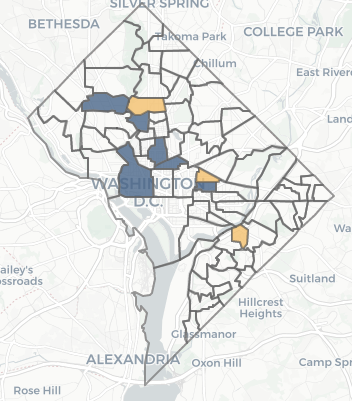The D.C. Policy Center report “Schools in the Neighborhood: Can Neighborhood Characteristics Explain Enrollment at In-Boundary Schools?” examines the connections between neighborhood characteristics and boundary school enrollment rates among the District of Columbia’s public school students, and finds there’s only one pocket of the city where a majority of families in public school choose their in-boundary middle or high school.
Schools in the Neighborhood constructs 109 neighborhoods around each DCPS in-boundary school, and assembles a profile of neighborhood characteristics and boundary participation rates for each in-boundary school. The report investigates how boundary participation rates in these neighborhoods vary with the neighborhood’s characteristics (such as race and ethnicity, household income, access to transit, safety, and proximity to charter schools) separately at the elementary school level and at the middle and high school level. The findings highlight schools that enroll a higher or lower proportion of in-boundary students compared to schools in neighborhoods with similar characteristics, and identifies neighborhood characteristics of areas where families are most likely to send their children to public charter schools.
Below is a summary of the report and its key findings. For more information, read the full report, download the report as a PDF, access the data and methodology, or explore the data.
The District of Columbia offers its families[1] a broad set of school options through its traditional public and public charter schools. Families frequently take advantage of these options, with only about a quarter of public school students attending their in-boundary schools—District of Columbia Public Schools (DCPS) that students have a right to attend based on their address—and the rest enrolling in out-of-boundary DCPS schools or public charter schools. But boundary participation rates vary greatly across neighborhoods, and in one area of the city, extremely high shares of students attend their in-boundary school.
Many studies focus on school quality (generally measured by results on standard assessments) to explain school choice patterns. Recent research shows that school location and demographics also influence enrollment decisions. That is, characteristics of neighborhoods in which highly popular in-boundary schools are located might also explain why some in-boundary schools have higher boundary participation rates and others do not. What drives these differences in school enrollment patterns across in-boundary schools in the District?
Families in the Wilson high school feeder pattern experience a very different public school system than the rest of the city.
Location within the feeder pattern for Wilson High School, D.C.’s top-performing in-boundary high school, outweighs all other neighborhood aspects in explaining the tendency to enroll at in-boundary schools. Families living in this area are the only ones in the city who overwhelmingly attend in-boundary schools, from elementary school through high school, over other options in DCPS or at public charter schools (see Figure 1). Six other in-boundary elementary schools (four in Capitol Hill, one downtown, and one in Dupont Circle) also have high boundary participation rates, but these rates dissipate beginning in the middle school years.
Figure 1. Boundary participation rates are highest within the Wilson High School boundary and its feeder schools
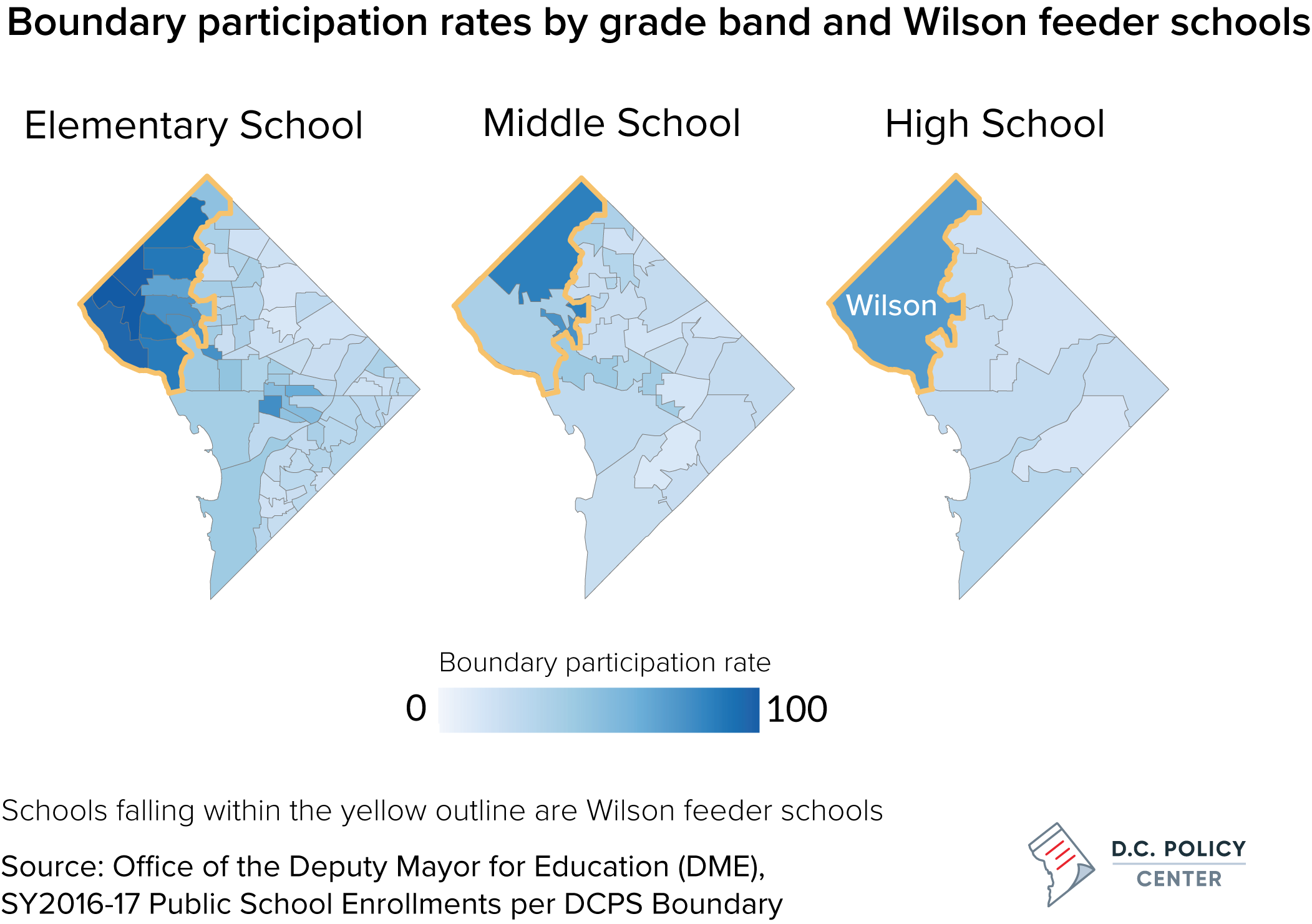

This dynamic underlies D.C.’s geographic divides in public school enrollment patterns: options offered by DCPS and public charter schools are least important for families who live in the Wilson HS area,[2] and extremely important everywhere else in the city. For example, the elementary school boundary participation rate is 79 percent at Wilson HS feeder schools, compared to 26 percent for schools elsewhere in the city (see Figure 2). The data can’t tell us exactly which aspects of Wilson HS or the surrounding area pull families to its in-boundary schools or neighborhoods, but this analysis shows that the “Wilson effect” is strong even when we control for academic performance of in-boundary schools, suggesting that the schools that feed into Wilson HS draw higher proportions of in-boundary students for reasons other than high test scores. District families prioritize a predictable feeder pattern for their children, as boundary participation is highest at Wilson HS feeder schools as early as when families are enrolling children in pre-kindergarten and elementary school.
Figure 2. Boundary participation is much higher for schools within the Wilson HS feeder pattern
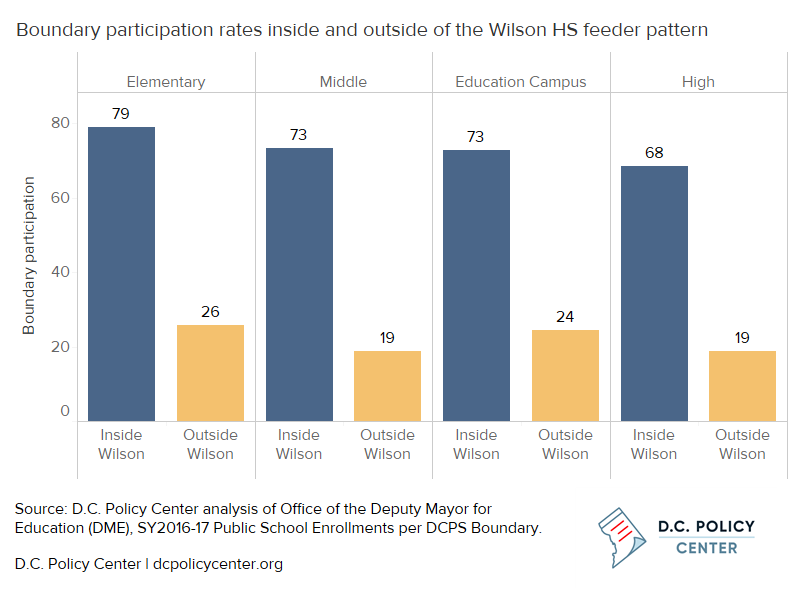

Neighborhoods with low or growing African American populations have higher boundary participation rates. Neighborhoods with higher poverty levels that are similar in other characteristics have relatively higher rates of boundary participation.
Even when controlling for the Wilson effect, we find that neighborhoods with a small or growing African American population have higher boundary participation rates at the elementary level. These neighborhoods tend to be majority white. While many of these neighborhoods are in the Wilson feeder pattern, some are not, suggesting that demographics matter in enrollment patterns, but to a lesser extent. Boundary participation rates also tend to be relatively higher in neighborhoods with higher poverty rates (controlling for other factors), where families appear to exercise options less frequently. This may be because poverty presents barriers—such as transportation—to attending other schools.
The importance of most neighborhood characteristics for school enrollment patterns is greatest for elementary schools and disappears in middle and high school grades (including access to transit). This could mean that neighborhood characteristics are much more important at the elementary level, when students may not be able to travel as far and when school boundary neighborhoods are smaller and more differentiated.
In-boundary elementary schools that enroll a higher or lower proportion of in-boundary students than expected are in changing neighborhoods.
A handful of in-boundary elementary schools draw higher or lower proportions of in-boundary students than expected after controlling for the schools’ neighborhood characteristics and for the “Wilson effect” (see Figure 3). Of the three schools that draw higher proportions of in-boundary students than expected, Powell ES and J.O. Wilson ES are located in racially diverse neighborhoods with declining African American populations. The third school, Orr ES, is located in a predominantly African American neighborhood with a rapidly growing school-age population compared to adjacent neighborhoods. The six schools that draw a lower share of in-boundary students than what our model predicts are in neighborhoods with proportionally fewer children than the average for the District. What is important here is not that these schools have low in-boundary enrollment levels overall, but that they have lower in-boundary enrollment levels than one would expect given their neighborhood characteristics.
Figure 3. Some schools have higher or lower participation than expected
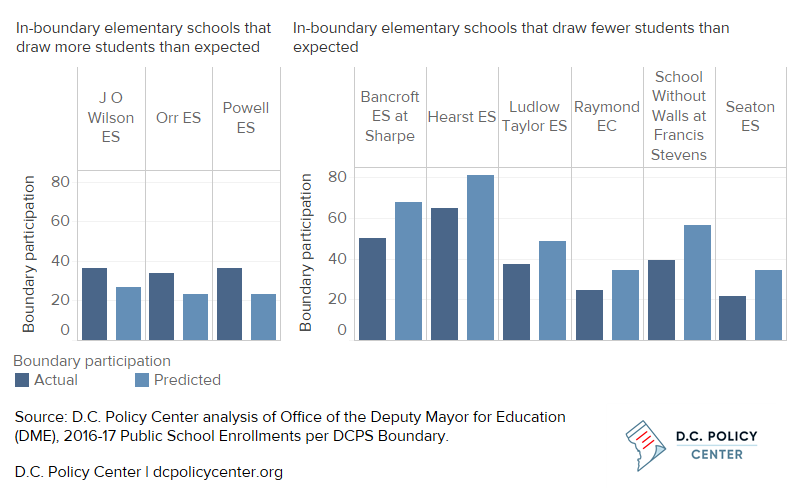

Public charter school participation is higher when there are more public charter schools in the neighborhood.
Our models find that the presence of public charter schools in a neighborhood is the most important neighborhood variable to enrollment at these schools aside from the demographic make-up of its population. As confirmation that proximity matters, at least 7 percent of elementary, middle, and high school students across the city attend a public charter school located within their school boundary (see Figure 4). This should not be interpreted causally, since public charter schools could be choosing their locations based on likely demand from families, cost of space, or other factors. However, Wilson HS likely plays a role here, too, as public charter school participation is lowest in neighborhoods that are in the Wilson HS feeder pattern, where there aren’t any public charter schools.
Figure 4. Some students attend public charter schools close to home
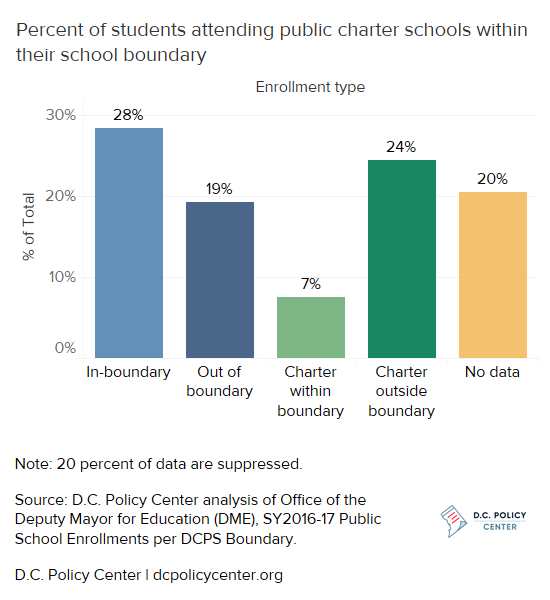

Private school enrollment in all grades is also highest within the Wilson HS boundary.
The highest private school enrollment rate across all grades (44 percent)[3] is found within the Wilson HS boundary neighborhood, which is also where the highest share of public school students attend their in-boundary school (see Figure 5). Although families in the Wilson HS boundary almost exclusively enroll at their in-boundary school if they are choosing public schools, almost half of families living in this area take advantage of private choices and opt out of public schools altogether.
Figure 5. Private school enrollment In all grades is highest within the Wilson HS boundary
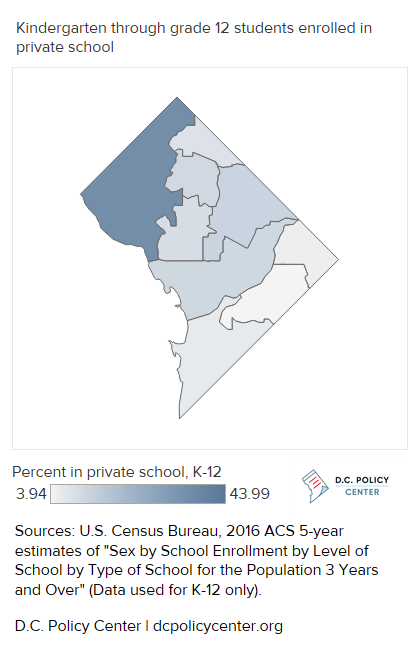

The analysis presented in this study points to several important findings for the District’s changing schools.
First, most families who live in the Wilson HS boundary experience a different set of school options than those who do not. These families have chosen to live in neighborhoods where many enroll in the elementary-through-high school in-boundary feeder pattern, and largely do not consider the alternative paths that DCPS and public charter schools offer (unless they enroll in private schools). Families who are not in the Wilson HS feeder pattern, however, frequently choose schools other than their in-boundary schools.
Second, the pull of Wilson HS can explain why the enrollment bump at the elementary level in the District’s public school system is not translating into similar growth at the middle and high school levels. The city has expanded its pre-kindergarten offerings to draw more students into the system, but the boost in enrollment appears to have been maximized in lower grades. The cohorts that created this enrollment bump beginning in the 2009-2010 school year have now reached 9th grade, but not all students are continuing in D.C.’s public schools. While families attend the city’s elementary schools, total public school enrollments decline in D.C. beginning in the middle school years, which could be related to the lack of a predictable education path from elementary to high school.
Click here to read the full report, download the report as a PDF, or access the data and methodology.
Chelsea Coffin is the Director of the D.C. Policy Center’s Education Policy Initiative.
The author is grateful to the Walton Family Foundation and EdForward DC for their generous support of the Education Policy Initiative. The paper benefited from helpful feedback and input from Dane Anderson, Kristin Blagg, Tomeika Bowden, Matt Chingos, Jennifer Comey, Steven Glazerman, Irene Holtzman, Claudia Luján, Sara Mead, Arthur McKee, Ginger Moored, Richelle Russell, and Jon Valant. At the D.C. Policy Center, Yesim Sayin Taylor and Kathryn Zickuhr offered crucial guidance, and Simone Roy provided incredible research assistance.
Notes
[1] Here and throughout, we use families to refer to parents as well as other familial caregivers who are involved with making school enrollment decisions.
[2] The value of the Wilson HS feeder location is largely capitalized into housing prices: the median estimated value per square foot for single family homes within the Wilson HS boundary is $547, compared to $396 citywide (see Taking Stock of the District’s Housing Stock: Capacity, Affordability, and Pressures on Family Housing).
[3] Given the calculated margins of error, this estimate could range from 40.0 percent to 47.9 percent.
